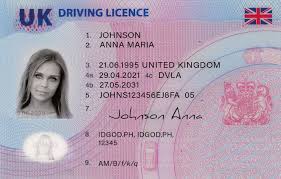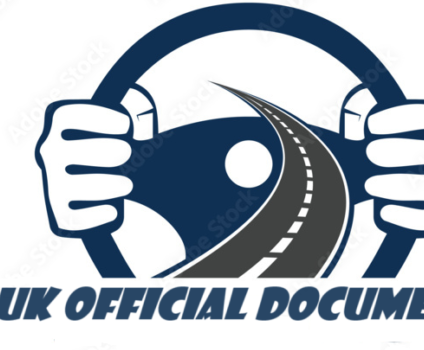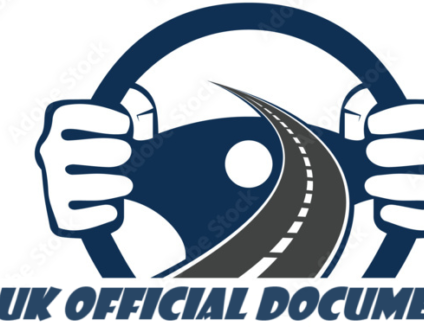Buy UK driver’s license
Buy UK driver’s license online
3.3 WHAT IS THE 12 SECOND RULE?
With many accidents happening as a result of motorists not looking far enough up the road, the 12-second rule works to ensure that drivers have enough room/time to notice and appropriately react to hazards in front of them. The rule maintains that drivers should always aim to scan the road at least 12 seconds ahead when driving.
While this might seem like a pretty long distance, knowing
what is happening up the road is the best way of avoiding trouble when driving – which makes looking ahead when driving a good habit to develop.
Judging how far 12 seconds actually is:
Pull over to the side of a reasonably straight road.
Start counting to twelve as soon as a car moves past you.
Note the distance between your vehicle and the car when you get to 12 seconds. That is how far ahead you should scan when driving.
You will need to look further than 12 seconds ahead when driving faster as the distance you cover within that time will be significantly more.
3.4 DRIVING IN TRAFFIC – PLANNING AHEAD AND STAYING ALERT
You need to plan your route in advance before driving on busy roads.
Planning ahead before you drive in a busy area means you Buy UK driver’s license have one less thing to worry about when driving. You also need to be aware of the traffic around you at all times when driving on busy roads for safety.
Do the following when driving in busy traffic:
Check your mirrors regularly.
Check your blind spots especially when you want to change lanes.
Keep on the lookout for motorcyclists and cyclists who might come through between lanes or on your left.
Be on the lookout for drivers making abrupt lane changes without signalling or pulling into small gaps in traffic.
Try to predict the actions of other drivers on the road so that you have more time to react if need be. Look for clues such as the direction drivers are looking, the direction their wheels are pointing to or small forward movements from side streets.
By doing these things, you’ll be able to identify and predict hazards so that you can take action to avoid an accident.
3.5 DECIDING WHEN ITS SAFE TO OVERTAKE
The most important aspect of overtaking is deciding when it’s safe to pass another vehicle and when it’s not.
There are a couple of things you need to consider before you decide whether it is safe to overtake or not. Buy UK driver’s license online
These are:
Your current speed. If you are already travelling at a speed that is equal or above the prescribed speed
limit, then it’s not only unnecessary to overtake, but also illegal. The need to pass another vehicle does not exempt you from speed limits.
The traffic ahead. Look ahead (at least 12 seconds away) to determine whether there is enough clear road for you to pass and pull in safely in front of the vehicle you have just passed. If there isn’t, don’t overtake.
The markings on the road. A dashed white line on your side of the road means you can overtake if it’s safe to do so. A single yellow line or two yellow lines, on the other hand, mean that you are not allowed to overtake.
Remember, you don’t have to overtake. If for any reason you’re not sure, don’t pass. Buy UK driver’s license online
4.0 GENERAL DRIVING
4.1 HOW TO DRIVE ON SEALED ROADS WITHOUT THE CENTRELINE
Sealed roads that don’t have a centreline are usually more winding and narrower than those that have a centreline. This significantly increases the risk of a head-on crash, as the lack of a centreline makes it harder for drivers to judge the position of their vehicle on the road.
Here are some tips for driving on sealed roads without a centreline: Buy UK driver’s license online
When driving on roads that don’t have a centreline, you
might need to stop in half the distance of the visible road in front of you to avoid a collision. So, make sure to maintain a speed that will enable you to do this.
Be on the lookout for driveways and intersections as they’re often hard to spot on country roads.
Position your car as far to the left as you safely can when driving.
Keep an eye out for pedestrians and cyclists as these roads usually lack designated paths for them.
Look out for other road users including farm vehicles such as tractors, quad bikes and even animals. Look as far as you can and be ready to stop.
Slow down when approaching bridges as they are only one way and you might be required to give way.
4.2 DRIVING ON UNSEALED ROADS
An unsealed road in simple terms is a road made of loose materials such as gravel or dirt. This kind of road is usually found in the country. You need to be calm and patient when driving on them so as to maintain full control of your vehicle. Buy UK driver’s license

Here are the things you should do to maintain control of your vehicle when driving on an unsealed road:
Keep your movements smooth and gradual i.e. do not make sudden movements when accelerating, braking or steering.
If a car approaches you, slow right down and steer your car as far to the left as you safely can. This will reduce your dust cloud and reduce the likelihood of loose stones chipping your windscreen.
Don’t pull over to the side of the road too quickly as gravel along the sides is often deeper and looser and can make it difficult to brake or steer.
If you happen to find yourself in deeper gravel, slow right down and steer the car out slowly. Don’t jack the wheel quickly as this could flip your car.
Make sure to increase the following distance as dust thrown up by another car can make
it difficult to see ahead.
4.3 HOW TO DEAL WITH SPECIAL VEHICLE LANES
There are different types of special vehicle lanes on the road; they include transit, bus and cycle lanes. These special lanes are differentiated from regular lanes by road markings or signs. You are not allowed to use these lanes if your vehicle does not meet the conditions set for driving on them.
You can, however, drive on a special vehicle lane if you are:
Turning, or
Driving to a vehicle entrance or parking space
Follow these steps when merging into a special lane:
Perform a mirror check.
Indicate for a minimum of 3 seconds.
Perform a blind-spot check.
Give way to all vehicles on the lane including cyclists.
Smoothly steer into the lane.
Once on the special lane, keep in mind that you are not allowed to drive on it for more than 50 metres while performing your manoeuvre
While some special vehicle lanes are in operation 24/7, others operate during a specific time.
Make sure to check and follow the rules for using any special vehicle lane.
5.0 DRIVING SKILLS
5.1 STEERING A CAR
Proper hand positioning is very important when steering a car. Your hands should firmly hold the steering wheel in the quarter to three position every time you’re driving. This is a safety precaution that ensures your hands don’t get in the way of the airbag in case of an accident.

When steering, always remember to:
Keep each hand on its side of the steering wheel; don’t cross them over when turning.
Pass the wheel from one hand to the other when turning so that your arms do not cross over the wheel.
Hold the wheel firmly (not so much as to strangle it) with your thumbs up and not locked around the wheel.
How to steer
When steering, you should:
Slow down to a safe speed before turning.
Make smooth adjustments to the car’s speed going in and out of turns.
Control the car out of turns – don’t let the car do it.
Look 12 seconds ahead to where you want to go instead of focusing on the road immediately in front.
Remember, steering takes practice so try it out in an empty space before you go out on the road.
5.2 WHEN TO INDICATE
Signalling or indicating is a simple safety and courtesy task that drivers are required to do when driving. It lets other road users know what you intend to do so that they can react accordingly.
You need to give adequate warning of your intention to allow other drivers, cyclists and pedestrians time to react to your signal. The minimum indicating time is 3 seconds.
You are required to indicate in the following situations:
When turning right or left.
When changing lanes or any other time you cross the centre line.
Whenever you have to move left or right by the width of your car or more.
When pulling out or into a kerb.
When entering or leaving a park.
When merging after your lane comes to an end such as when joining a motorway from a feeder lane.
At roundabouts.
Remember to always turn off your indicator (if it doesn’t do so automatically) after making your turn to avoid confusing other road users.
5.3 URBAN DRIVING – HOW TO DEAL WITH TRAFFIC LIGHTS
Traffic lights are a major part of driving in urban areas. Their job is to control the flow of traffic at busy intersections where many vehicles might want to pass at the same time.

Here is how you should approach and drive through intersections controlled by traffic lights:
Prepare to stop as you approach the intersection
If the green light turns yellow, you are required to stop if it’s safe to do so.
You should be aware of where the ‘point of no return’ is. This is the area where you won’t be able to stop safely. If the light switches to yellow when you are beyond this point, don’t change your mind and jam on the brakes as it will already be too late.
Keep the blocking rule in mind
Ensure there is a big enough space on the other side of the intersection before you enter – otherwise, you will get stuck in the middle once the lights change.
You can use the intersection as you wait to turn
If you want to turn right, there isn’t a right-turning arrow, and nobody else is already waiting in the intersection, you’re allowed to drive into it and wait for a gap in the traffic flowing straight through.
Turn right when it’s safe to go, even when the lights change to yellow or red – but ensure straight-through traffic has stopped before turning in front of them.

